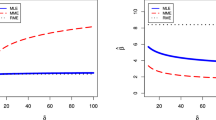Abstract
Batch process industries are characterized by complex precedence relationships among operations, which makes the estimation of an acceptable workload very difficult. Previous research indicated that a regression-based model that uses aggregate job set characteristics may be used to support order acceptance decisions. Applications of such models in real-life assume that sufficient historical data on job sets and the corresponding makespans are available. In practice, however, historical data maybe very limited and may not be sufficient to produce accurate regression estimates. This paper shows that such a lack of data significantly impacts the performance of regression-based order acceptance procedures. To resolve this problem, we devised a method that uses the bootstrap principle. A simulation study shows that performance improvements are obtained when using the parameters estimated from the bootstrapped data set, demonstrating that this bootstrapping procedure can indeed solve the limited data problem in production control.

Similar content being viewed by others
References
Ford FN, Bradbard DA, Ledbetter WN and Cox JF (1987). Use of operations research in production management. Prod Invent Mngt J 3rd Qtr: 59–62.
Lane MS, Mansour AH and Harpell JL (1993). Operations research techniques: a longitudinal update 1973–1988. Interfaces 23: 63–68.
Ragatz GL and Mabert VA (1984). A simulation analysis of due date assignment rules. J Opns Mngt 5(1): 27–39.
Cheng TCE and Gupta MC (1989). Survey of scheduling research involving due date determination decisions. Eur J Oper Res 38: 156–166.
Vig MM and Dooley KJ (1991). Dynamic rules for due date assignment. Int J Prod Res 29(7): 1361–1377.
Vig MM and Dooley KJ (1993). Mixing static and dynamic estimates for due date assignment. J Opns Mngt 11: 67–79.
Gee ES and Smith CH (1993). Selecting allowance policies for improved job shop performance. Int J Prod Res 31(8): 1839–1852.
Raaymakers WHM, Bertrand JWM and Fransoo JC (2000). Using aggregate estimation models for order acceptance in a descentralized production control for batch chemical manufacturing. IIE Trans 32: 989–998.
Ivanescu CV, Fransoo JC and Bertrand JWM (2002). Makespan estimation and order acceptance in batch process industries when processing times are uncertain. OR Spectrum 24: 467–495.
Efron B (1979). Bootstrap methods: another look at the jackknife. Ann Stat 7: 1–27.
Raaymakers WHM, Bertrand JWM and Fransoo JC (2000). The performance of workload rules for order acceptance in batch chemical manufacturing. J Intell Manuf 11: 217–228.
Raaymakers WHM and Hoogeveen JA (2000). Scheduling multipurpose batch process industries with no-wait restrictions by simulated annealing. Eur J Opns Res 126: 131–151.
Leon VJ, Wu SD and Storer RH (1994). Robustness measures and robust scheduling for job shops. IIE Trans 26: 32–43.
Carlier J (1987). Scheduling jobs with release dates and tails on identical machines to minimize the makespan. Eur J Opns Res 29: 298–306.
Montgomery DC and Peck EA (1992). Introduction to Linear Regression Analysis. Wiley: New York.
Efron B and Tibshirani RJ (1993). An Introduction to the Bootstrap. Chapman & Hall: New York.
Author information
Authors and Affiliations
Corresponding author
Rights and permissions
About this article
Cite this article
Ivănescu, V., Bertrand, J., Fransoo, J. et al. Bootstrapping to solve the limited data problem in production control: an application in batch process industries. J Oper Res Soc 57, 2–9 (2006). https://doi.org/10.1057/palgrave.jors.2601966
Received:
Accepted:
Published:
Issue Date:
DOI: https://doi.org/10.1057/palgrave.jors.2601966




